
French postcard by Cinémagazine-Edition (CE), no. 531. Photo: Walery, Paris. Josephine Baker in La revue des revues/Parisian Pleasures (Joe Francis, 1927). Collection: Marlene Pilaete.
Josephine Baker (1906-1975) was well-known as a singer and dancer. In 1925 she became an instant success in Paris, because of her erotic dance. She also performed in a handful of silent and early sound films, La Sirene des Tropiques (1927), Zouzou (1934) and La princesse TamTam (1935).
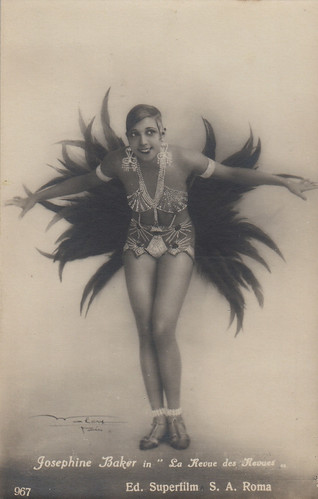
Italian postcard by Ed. A. Traldi, Milano, no. 967. Photo: Walery. Collection: Marlene Pilaete. You will notice a difference between this postcard and the previous one: a bra covering Josephine Baker’s breasts. Italian editor Traldi chose to censor Josephine’s nakedness and print a retouched photo, possibly in a bout of prudery?

British postcard by Beagles Postcards, no. 707 C. Photo: Ellis & Walery. Publicity still for the stage play 'The Only Way'.
British Actor-manager Sir John Martin Harvey (1863-1944) was one of the last great romantic actors in the English theatre. His most famous play was 'The Only Way' (1899), an adaptation of Charles Dickens' 'A Tale of Two Cities'. 25 years later, he also featured in the film version, as well as in a few other silent and sound films.
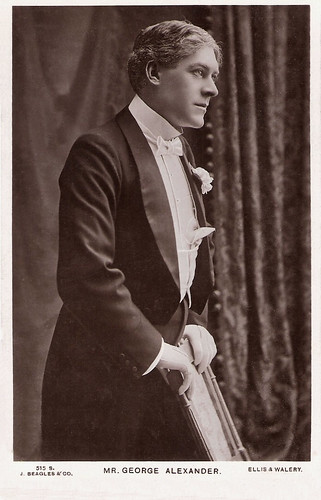
British postcard by J. Beagles & Co, London, no. 515 S. Photo: Ellis & Walery.
Sir George Alexander (1858-1918) was an English actor and theatre manager. One of his most famous stage roles was in 'The Prisoner of Zenda' by Anthony Hope, which premiered in 1896.

British postcard by Rotary, no. 1212C. Photo: Ellis & Walery. Publicity still for the play 'The Devil's Disciple' (1907).
Tall and good-looking Matheson Lang (1879-1948) was a Canadian-born stage and film actor and playwright in the early 20th century. He is best known for his Shakespearean roles in British productions of 'Hamlet', 'Macbeth', and 'Romeo and Juliet' and for his role as Mr. Wu. He was one of the first major stars of the British theatre who acted in a silent film and during the 1920s, he became a popular film star in Great Britain.
A Regent Street studio
Stanisław Julian Ignacy Ostroróg was born in 1863 in London into a family of political emigrants of Polish noble descent. He was the eldest child of Count Stanisław Julian Ostroróg, a British subject and his Polish wife, Teodozja Waleria, née Gwozdecka. His father was born in the Russian Partition of what had once been the Polish–Lithuanian Commonwealth, not long after the November uprising of 1830 which led to severe repression of the insurgents, of which the family had been part.
After the war, his father settled in London and was granted citizenship in 1862 and married. After the birth of Stanisław junior, the family headed to Marseille to set up a photographic studio. In 1866 the family were back in Warsaw, but the following year after the death of the second son, they left for Paris in time for the birth of the third son, Leon. There Ostroróg senior resumed his successful photographic career under the brand name "Walery" (without an accent), in honour of his wife's first name.
In 1878 his creditor's financial difficulties forced him to give up trading and the family moved back to London in 1880. He opened a Regent Street studio where Stanisław junior was eventually to join his father.
Although born in England, Stanisław junior was sent to Poland, presumably to relatives, to learn Polish while his parents returned to France where his father developed his photographic career. In 1871, during the Paris Commune, he was sent there for his schooling. During that period, his parents divorced and his father remarried. At around 18 years of age and following family tradition, he obtained a commission in the army, only this time in the Royal Artillery at Woolwich. This was short-lived as he evinced an interest in his father's business and resigned from the army.
At his father's insistence, he went to Paris for two years to study the techniques of photography, including portraiture. He returned to England to rejoin his father, who by then was enjoying great success and found he was not needed in the studio and so accepted a proposal to go to Mexico for a year helping in the construction of a railway and opening up a colony. He spent the next few years travelling with a camera and survey instruments in Africa, to places like Natal and Zululand. The sudden death of his father from an aneurism brought him back to London, where he took over the management of his father's studio in 1890.

British postcard by J. Beagles & Co., London, no. 1408. Photo: Ellis & Walery.
English actress Eva Moore (1870–1955) had a career on stage and in the film which spanned six decades. She was active in the women's suffrage movement, and from 1920 on she appeared in over two dozen films.
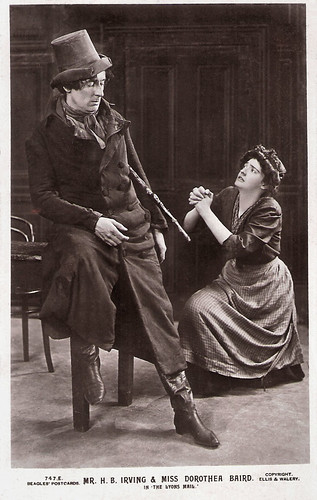
British postcard by J. Beagles & Co., London, no. 747 E. Photo: Ellis and Walery. Publicity still for the stage production of The Lyons Mail (1905).
The play 'The Courier of Lyons' (1854) by Charles Reade was a very popular stage work of the Victorian era. A respectable French gentleman is mistaken for his doppelganger, a notorious highwayman. The double roles of the villain Dubosc and the hero Lesurques had been previously played by Henry Irving and, after his death, were taken on by his son, H.B. Irving. His stage version of The Lyons Mail was in 1916 turned into a British silent film with Irving again as Lesurques / Dubosc, but now without his wife Dorothea Baird in the cast. The film version was directed by Fred Paul and produced by the Ideal Film Company, one of the leading British silent film studios.

British postcard. Photo: Ellis & Walery. Publicity photo for a stage production of 'The Breed of the Treshams'.
John Martin Harvey played Reresby 'the Rat' in many stage productions between 19003 and 1934 as well as in the film The Breed of the Treshams (Kenelm Foss, 1920) with Mary Odette.

British postcard by J. Beagles & Co., Ltd., Printers & Publishers, no. 516 B. Photo: Ellis & Walery. Publicity photo for a stage production of 'The Prisoner of Zenda'.
Sir George Alexander (1858-1918) was an English actor and theatre manager. One of his most famous stage roles was in 'The Prisoner of Zenda' by Anthony Hope, which premiered in 1896.

British postcard by J. Beagles & Co., no. 273 L. Photo: Ellis & Walery. Photo: publicity still for the stage production of 'The Lyons Mail' (1905) with Irving as Lesurques.
H.B. Irving (1870-1919) was a British stage actor and actor-manager. He was the eldest son of Sir Henry Irving. Despite his many roles on stage and in the silent cinema, Irving is now best known for 'A Book of Remarkable Criminals' (1918), which he wrote as a legal expert.
A Paris studio in rue de Londres
Stanisław Ostroróg junior was inspired to learn photographic techniques by his photographer father. He had worked briefly alongside him in the London studio named after his mother, Walery Ltd. After his father's death, however, he found the business side a struggle and soon went into partnership with the ambitious young English theatrical photographer, Alfred Ellis (1854–1930) and began trading as Ellis & Walery from new premises in Baker Street until 1908.
For four years between 1890 and 1894, he worked on developing a Heliogravure process for the reproduction of art, although that did not produce the results he desired until much later in Paris. In the meantime, he continued with portraits of society people including royalty as his father had done earlier. The NPG records that Walery, father and son, is associated with 197 portraits, including comedian Dan Leno and King George V, while Ellis has 180 portraits to his name, mainly of "theatrical royalty". They appear to have kept their authorship and sitters separate while sharing studio facilities.
Around 1900, Stanisław Ostroróg opened a Paris studio on his own account, in his father's former premises, at 9bis rue de Londres, where initially he specialised in theatre and cabaret artists including Mata Hari and produced Cabinet cards. As his French business prospered he gave up his London interest in 1908. His Parisian clients included the Folies Bergères, the Société de Géographie, the salons de peintures, and a series for Les Grandes Figures médicales contemporaines. He was the official photographer for the 1912 Russian Season in Paris.
In the 1920s he focused on Art Photography and experimented with the figure of the model, entirely eschewing aspects of background and other perquisites. During this period he used the pseudonym "Laryew" and under that name produced a book of 100 heliogravures, entitled Nus – Cent Photographies Originales. He achieved the greatest acclaim with his series of photographs of Josephine Baker, published in 1926. He also produced studies of the female nude destined for anatomy and art students.
Stanisław Ostroróg married Joyce Audrey Rede Fowke (1877–1930), a granddaughter of Sir Henry Cole, in 1897 in Chelsea. They had four children, Francis who died in infancy, Stanislaus John, Joyce and Sally. During his career, he used numerous pseudonyms such as Lucien Waléry, Stanislas Walery, Laryew or Yrelaw (an anagram of Walery), the latter two perhaps to conceal a production of pictures of an erotic nature. Stanisław Julian Ignacy Ostroróg died in Paris in 1929. After his death, the studio was taken over by Charles Auguste Varsavaux (1866-1935).

French postcard. Photo: Walery, Paris. Mayol as Dandy and Arlette Dorgère as Prince Charming in the stage production 'Cinderella' (1906) at Théâtre de la Porte Saint-Martin in Paris. Caption: en route.
Félix Mayol (1872-1941) was a popular French singer of the Belle Epoque. He became a success in Paris in 1895 as a singer performing in a campy, effeminate way. His hair tassel inspired many imitators. In 1905, he performed at Gaumont in 14 phonoscènes under the direction of Alice Guy.
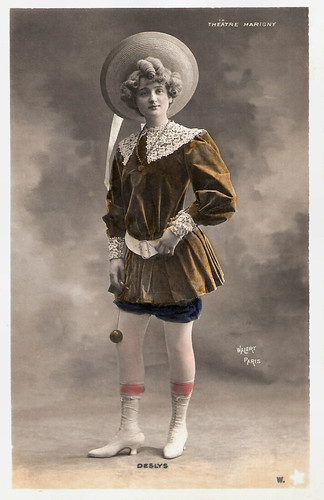
French postcard by Étoile, Série no. 677 - Th. 50. Papier Guileminot. Photo: Walery, Paris. Caption: la Theatre Marigny.
French dancer and actress Gaby Deslys (1881-1920) (aka Gaby Delys) was an internationally celebrated - and notorious - star of the early 20th Century. She was famous for her extravagant clothes, jewels, and millinery. She had many admirers, most notably King Manuel II of Portugal, and during World War I, she reportedly worked as a spy for the French government. Before her tragic early death, she also made a series of silent films.

French postcard by Editions P-C, Paris, no. 114. Photo: Walery, Paris. Georges Milton sang the one-step march 'Adieu... Adieu...' (Adieu, mon petit officier) in the stage operetta 'L'auberge du cheval blanc' (The White Horse Inn). Text by René Dorin and music by Robert Stolz (music). Copyright: Alrobi, Berlin / Editions Salabert, Paris, in 1930.
Georges Milton (1886-1970) was a French singer and actor. With his daring, merry songs Milton expressed the atmosphere of the French roaring twenties. He peaked in the French cinema of the 1930s as the character Bouboule.

French postcard by Editions artistique de Walery. Photo: Walery, Paris. Publicity still for the play 'Giska la Bohémienne' (1908) by Ed. Leroy.
Georges Wague (1874-1965) was a French mime, teacher and silent film actor. Between 1907 and 1922 he also performed in more than forty films. He started his film career with the silent film L'Enfant prodigue/The Prodigal Son (Michel Carré, 1907), where he played a Pierrot. His last film performance was in Faust (Gérard Bourgeois, 1922).
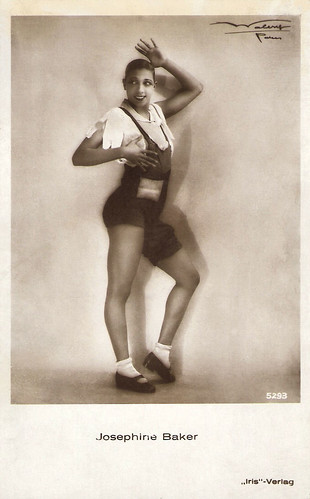
Austrian postcard by Iris Verlag, no. 5293. Photo: Walery, Paris.
Josephine Baker (1906-1975) was well-known as a singer and dancer. In 1925 she became an instant success in Paris, because of her erotic dance. She also performed in a handful of silent and early sound films, La Sirene des Tropiques (1927), Zouzou (1934) and La princesse TamTam (1935).
Sources: Wikipedia (French and English).
No comments:
Post a Comment